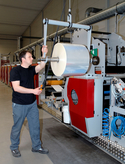Web offset sets off
17 September 2008Sonali Advani visits Müller Martini’s German factory and speaks to Bernd Schopferer on the competitive edge of web offset presses
Think ‘Müller Martini’, and you won’t be wrong to think print finishing equipment. Yet the Swiss manufacturer has also quietly but surely established itself in the area of high quality printing presses.
Headquartered in the quaint town of Maulburg, in southern Germany, Müller Martini Druckmaschinen manufactures the Alprinta, Alprinta V and Concepta web offset presses. Launched in 2004, the Alprinta, designed for the production of commercial work and mailings, is also offered as the Alprinta V option for the flexible packaging and labels market.
“Although we are not so well known for printing presses,” admits Bernd Schopferer, product and marketing manager of the press division, “we are in a very good sales position - we are completely booked for 2008 and new orders are being taken for 2009.”
Printing presses are neither new to Müller Martini, nor to its Maulburg facility. When the Swiss giant ventured into variable web offset presses 40 years ago, the German site became the centre of production.
In-house edge
Spread across 25,000m2, this plant accounts for 50 per cent of the production of machine parts needed for the company’s printing presses. “Although ‘out-sourcing’ may sound a modern strategy, our in-house production capabilities give us a distinct edge over our competitors,” explains Bernd Schopferer.
Apart from the benefits of quality control and effective tracking, in-house production allows Müller Martini to respond quickly to its customers’ urgent needs. “We can make it happen because we are not dependent on third party vendors,” he adds.
It’s not just the assembly lines, the German facility also maintains over 4,000m2 of stock for spare parts and hosts a training centre for its customers and apprentices. “We invite the customers to check the machine before it’s shipped. A thorough test run is carried out here as it is always easier to correct any inefficiencies here rather than miles away at a customer’s site,” he stresses.
Webbing its way
A job on hand for Müller Martini is to convince traditional flexo, rotogravure and sheet-fed offset customers to move to web offset. Although other technologies allow variable print repeat lengths to be produced cost effectively, the plate costs for web offset might just be the push needed to attract package printing converters.
Also, today the brand owners are looking for unique designs and pack sizes. While this adds cost pressure onto traditional converters, it could well be an opportunity for web offset.
“The low plate costs are perfect for frequent design changes and for jobs with low profitability of repeat orders,” Bernd Schopferer points out.
Web offset not only allows quick size change, but the process can run solvent free with the curing carried out through UV or EB. “This is an attractive option for food packaging converters as UV/EB curing has received FDA approval,” he states.
Moreover, there are no residual inks, and a large inventory of inks, cylinders or plates is not needed. Another advantage is its quick and easy plate mounting. “It takes only one minute to fix a plate as compared to 10 in flexo. Also, the short web passages in the printing press mean reduced waste,” he points out.
But probably, one of the biggest plus points of web offset presses is that they are modular and customisable, which is evident from the fact that Müller Martini has more than 20 machines installed in the package printing market and not one is exactly similar to any other.
For example, 3P, a label and packaging converter based in Baden-Baden, Germany, runs an Alprinta V press which is equipped with seven UV offset printing units, one flexo printing unit with lamination station and a rotary die cutter with non-stop matrix removal. The press has a number of Hönle UV curing units.
On the other hand, the Alprinta V at Poznan, Poland, based food packaging converter Europrint is completely different. It has six offset printing units with EB curing and two gravure printing units to allow good coverage of opaque white on PET films.
“Adding two printing units to a web offset press may take only three days, which in the case of gravure is a mammoth task and in the case of CI machines, not possible at all,” Bernd Schopferer stresses.
“We understand that web offset is a complicated printing process and calls for higher investment costs in terms of prepress, machine and spare parts, but its advantages on plate cost, print quality, short runs and lead time all support the technology for the package printing segment,” he concludes.
1
Alprinta V line at 3P Spezialdruck, Baden-Baden Alprinta V at 3P Reel change and laminating station at 3P Alprinta V at 3P Die cutting and matrix removal Alprinta V at 3P Related ArticlesProductivity is the magic word Absolutely authenticExternal weblinksConverting Today is not responsible for the content of external internet sites.Müller Martini




